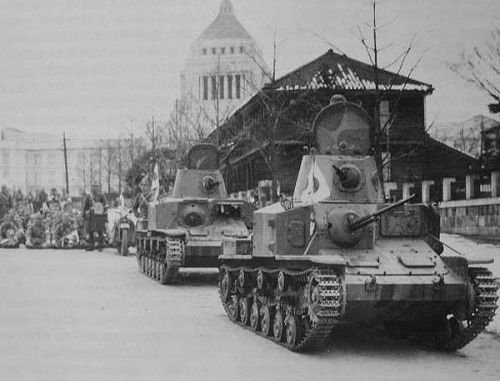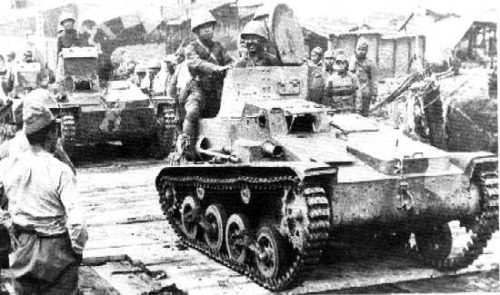Tanks of the Rising Sun Part II — The Tiny Widdle TankettesIn case you missed: Intro, Part 1Ta
Tanks of the Rising Sun Part II — The Tiny Widdle TankettesIn case you missed: Intro, Part 1Tankettes were a short lived oddity common in the 1920’s and 1930’s which did not live past World War II. Essentially a tankette is a tiny little “mini tank”, which is so lightly armed and armored it doesn’t even meet the classification of a light tank. Most European powers experimented with tankettes as they were much cheaper than regular tanks and thus an easy way to motorize forces. However due to their vulnerability to new anti-tank weaponry and lack of firepower they could bring to bear, most nations discontinued combat use after the first year of World War II. Japan in the 1930’s was no exception, and it’s experiment with tankettes resulted in three models.The first model developed was the Type 92 Heavy Armored Car. It was classified as an armored car because it was designed for use by the cavalry, and the cavalry could not adopt the name “tank” or “tankette” for their vehicles. Technically tanks were to be exclusively used by the infantry. The Type 92 was developed as part of the IJA cavalry’s plan to motorize by replacing their horses with trucks, armored cars, and tankettes. The Type 92 was armed with two 6.5mm machine guns, one in the hull and another in the turret. Later the turret hull gun was replaced with a heavier 13.2mm machine gun. It’s crew consisted of only two, a driver who also operated the hull mounted machine gun, and a commander who operated the turret machine gun. Maximum armor, which was at the front, was 12mm, which was enough to stop most small arms fire. However it’s side and rear armor was a mere 6mm, which could be penetrated with well aimed rifle fire using armor piercing ammunition. Weighing 3.9 tons with a 45 horsepower four cylinder gasoline engine, it had a top speed of 40 km/h. The Type 92 first saw production in 1932 just in time for combat in Manchuria and China. While it was the first it was also the worst, suffering several mechanical problems including engine failures and transmission breakdowns. As a result the Type 92 was redesigned several times throughout its manufacturing run between 1932 and 1939. On four separate occasions production runs of Type 92’s had to be taken out of service and essentially remanufactured to correct design flaws. Due to it’s poor reliability, only 167 were produced.After the cavalry adopted tankettes the infantry too wanted in on the tankette fad. In 1935 the IJA adopted the Type 94 which was to be lighter than the Type 92 and used for infantry support. The Type 92 again was manned by two person crew, a driver and a commander, who also acted as the gunner. It was armed with only one machine gun, a 6.5mm mounted in the turret, which was later replaced with a 7.7mm machine gun. Frontal armor was 12mm while side armor was increased to 8mm, which was better than the Type 92’s but still paper thin. With a 32 horsepower four cylinder gasoline engine this tiny little 3.4 ton war machine had a top speed of 40 km/h. Production only lasted from 1935 to 1937 with 823 produced. In a typical IJA infantry regiment a company of six Type 94’s would be attached for support. The tankettes were used as fire support, each acting as an armored machine gun crew. They were also used for reconnaissance and since they were outfitted a towing device they often carried a trailer full of supplies for the regiment. It was not uncommon for them to be used to tow light artillery as well.The final Japanese tankette is the Type 97, which was an replacement of the Type 94 that was closer to a light tank than a tankette. The new Type 97 used a modified form of the Type 94 chassis, however instead of a single machine gun it featured a 37mm cannon mounted in the turret and 7.7mm machine gun mounted in the hull. The engine was replaced with a 65 horsepower diesel engine which could propel it at a top speed of 40 km/h. Armor was similar to that of the Type 94 (paper thin) and weight was increased to 4.7 tons. Production lasted from 1936 until 1937 with 616 being produced.By the start of the Second Sino Japanese War in 1937 it was becoming clear that the tankette was too deficient for frontline combat, falling easy prey to anti-tank weapons and even normal infantry small arms. Thus between 1937 and 1939 all japanese tankette production ceased. Tankettes remained in service throughout World War II, but were almost always used for logistical support such as towing carriers of supplies or towing light artillery. Combat involving Japanese tankettes during World War II was rare for obvious reasons. -- source link
Tumblr Blog : peashooter85.tumblr.com
#history#tanks#tankettes#armored warfare#tank warfare#wwii

